Systematic bibliometric analysis of research hotspots and trends on the application of premium lOLs in the past 2 decades
Liang-Pin Li, Li-Yun Yuan, De-Shen Mao, Xia Hua, Xiao-Yong Yuan
1Clinical College of Ophthalmology, Tianjin Medical University, Tianjin 300020, China
2Tianjin Key Laboratory of Ophthalmology and Visual Science, Tianjin Eye Institute, Tianjin Eye Hospital, Tianjin 300020, China
3School of Medicine, Nankai University, Tianjin 300071,China
4Anhui Medical University, Hefei 230032, Anhui Province,China
5Tianjin Aier Eye Hospital, Tianjin University, Tianjin 300190,China
Abstract
· KEYWORDS: premium intraocular lens; bibliometric;H-index; cataract surgery; global trends
INTRODUCTION
According to WHO statistics, as of 2020, there were approximately 100.49 million individuals worldwide suffering from moderate to severe visual impairment and even blindness caused by cataracts[1].The prevalence of cataracts in individuals over the age of 80 is as high as 90%[2].With a rapidly aging global population, the number of cataract patients is steadily increasing, underscoring the significant impact of cataracts on global health.
For over five decades, the standard treatment for cataracts has been phacoemulsification combined with intraocular lens(IOL) implantation[2-4].However, following the implantation of traditional monofocal IOLs, patients—especially those with significant corneal astigmatism—often experience a loss of accommodation in their crystalline lens and frequently find the need for one or even two pairs of glasses to achieve clear vision at different distances[5].In addressing these issues,premium intraocular lenses (PIOLs), including multifocal/extended depth of focus (EDoF) and Toric IOLs, have emerged.Multifocal IOLs utilize diffraction, refraction, or a combination of both optical principles to focus incident light rays onto different focal points, relying on the principle of simultaneous vision[6].EDoF IOLs leverage various technologies such as spherical aberration and pinhole imaging to extend the depth of focus for single or multiple focal points,resulting in a continuous range of vision, providing excellent distance and intermediate vision[7-9].Toric IOLs, on the other hand, correct residual corneal astigmatism by incorporating cylindrical optics into the optical design[10].The application of these technologies, both individually and in combination,serves to reduce postoperative dependence on glasses and offers an enhanced overall vision[11].With the emergence and widespread utilization of PIOLs, cataract surgery has entered a new era, not only replaced the opaque lens but also precisely corrected various refractive errors[12].As a result, it is now commonplace to opt for cataract surgery, often referred to as refractive lens exchange, to correct conditions such as high myopia, presbyopia, and astigmatism[13-18].
Bibliometrics, as an informatics method, holds distinct advantages and utility in the domain of medical research[19-21].This study centers on the intrinsic development of IOL and investigates its evolution as the central theme, encompassing publications and reviews spanning the last two decades.We employed CiteSpace for literature reduction, quality control, and keyword analysis.The R package Bibliometrix served as the primary tool for bibliometric analysis, and CitNetExplorer facilitated cluster analysis.Through a comprehensive examination of relevant articles, we delved into the historical development of the discipline, scrutinized intricate collaborative relationships among countries,institutions, and authors, and illuminated cutting-edge research topics.Bibliometrics, by shedding light on potential trends, can anticipate emerging research areas and enrich understanding within the field.Despite the efficacy of PIOLs,there remains room for improvement, given associated side effects such as dysphotopsia, halos, glare, and issues with neuroadaptation[22-24].To assist researchers in navigating the historical evolution and current research focal points of PIOLs,thereby facilitating exploration of emerging research avenues and identification of future development trends, we conducted a bibliometric analysis of relevant literature published from January 2000 to December 2022.
MATERIALS AND METHODS
The search for papers included in this study was carried out in December 2022 through the Web of Science (WoS) Core Collection provided by Clarivate (Philadelphia, PA, USA).Since the data in this study were derived from publicly available data in public databases and did not involve new human or animal experiments, ethical proof was not required.Only “articles” and “reviews” were included as document types and were limited to “English-language” papers.This search covered the period from January 1, 2000,to December 31, 2022.The final search formula was(TI=(multifocal “intraocular lens”) OR TI=(multifocal IOL) OR TI=(MfIOL) OR TI=(bifocal “intraocular lens”)OR TI=(bifocal IOL) OR TI=(trifocal “intraocular lens”)OR TI=(trifocal IOL) OR TI=(“extended depth of focus”“intraocular lens”) OR TI=(“extended depth of focus” IOL)OR TI=(EDoF IOL) OR TI=(EDoF “intraocular lens”) OR TI=(“zonal refractive” “intraocular lens”) OR TI=(“zonal refractive” IOL) OR TI=(toric “intraocular lens”) OR TI=(toric IOL) OR TI=(premium IOL) OR TI=(premium“intraocular lens”) OR TI=(premium “intraocular lenses”)OR AB=(multifocal “intraocular lens”) OR AB=(multifocal IOL*) OR AB=(MfIOL) OR AB=(Bifocal “intraocular lens”)OR AB=(bifocal IOL) OR AB=(trifocal “intraocular lens”)OR AB=(trifocal IOL) OR AB=(“extended depth of focus”“intraocular lens”) OR AB=(“extended depth of focus” IOL)OR AB=(EDoF IOL) OR AB=(EDoF “intraocular lens”) OR AB=(“zonal refractive” “intraocular lens”) OR AB=(“zonal refractive” IOL) OR AB=(toric “intraocular lens”) OR AB=(toric IOL) OR AB=(premium IOL) OR AB=(premium“intraocular lens”) OR AB=(premium “intraocular lenses”)AND DT=(Article OR Review).Book chapters, online published papers, conference transcripts, and withdrawn publications were excluded from the search results.After thoroughly reading the title, abstract, and keywords of the search results, we excluded literature that had poor relevance to the research topic, did not meet the inclusion criteria or met the exclusion criteria.Then we examined the preliminary screening literature and derived a text file containing “fully recorded and cited references”.Each document included basic information about the content, author, and publication and all citation information.
We used CiteSpace software (version 5.7.R5W, http://cluster.ischool.drexel.edu/~cchen/citespace/download) to deduplicate the data and remove entries with incomplete records.First,the text format file was imported into the CiteSpace, and in the data processing utilities, the data source was set to WoS.Then the “remove duplicates” option was selected to filter out repeated literature and literature without a publication date.The final set of literature for research and analysis was obtained through this process.Top authors, countries, institutions,journals, and collaboration network were identified by the R package Bibliometrix (https://www.bibliometrix.org/home/).Similarly, the H-index calculation employs Bibliometrix,utilizing the literature retrieved in this study as the database.CitNetExplorer (Version 1.0.0) was used to conduct cluster analysis.CiteSpace was used for keyword detection and Citation Burst analysis of references.Finally, Microsoft Charticulator (version 2.0.https://charticulator.com/) was used to plot chord diagrams.
RESULTS
General DataUsing the above search strategy, we found a total of 2052 articles, and 1801 articles verified and deduplicated by CiteSpace software were included in this analysis.These articles were cited a total of 14 715 times(including self-citations), came from 145 journals, involved 4561 authors, included 1684 articles and 117 review articles.Almost all the literature was classified as ophthalmology based on the topics of cited studies.
The annual publication volume is shown in Figure 1.The annual growth rate was 13.32%, and an average of 78.3 articles were published each year.From 2000 to 2006, few articles were published, with an average annual volume of 12.4.During the 10y from 2007 to 2016, the number of articles about PIOLs increased steadily, with an average annual volume of 72.4.From 2017 to 2022, the number of articles increased even more rapidly, reaching 164.7 articles a year, almost 13 times the initial annual volume of the search period.
Country or Region DistributionA total of 65 countries were involved in the PIOLs research during this period.Worldwide, regions with many published documents were mainly concentrated in Europe, America, and Asia.Spain ranked first in number of published documents, followed by the United States (n=741), China (n=437), Germany (n=336),and Japan (n=284).Spain and the United States have been far ahead in the total number of documents since 2006, while China has increased rapidly after 2016, becoming the third largest country (Figure 2A) in 2019.In terms of international cooperation, we can see those countries producing a large number of papers, such as Spain, the United States, Germany,the United Kingdom, and Australia, have very frequent academic exchanges with various countries.However,China, Japan, and Brazil have relatively rare international collaborations.Although South Korea has many papers, it only has collaborative relationships with Germany and the United States in this field (Figure 2B).
Institutional DistributionTable 1 shows the top 10 institutions,of which the top five are the University of Valencia (Univ Valencia), Ruprecht Karls University Heidelberg (Heidelberg Univ), University of Oviedo (Univ Oviedo), Universidad Miguel Hernandez de Elche (Univ Miguel Hernandez), and Universit?t d’Alacant (Univ Alicante).Except for Heidelberg Univ in Germany, the other four institutions were in Spain.The number of articles published by Univ Valencia and Univ Oviedo increased greatly after 2006, while that of Univ Miguel Hernandez and Univ Alicante started to rapidly increase after 2010, and that of Heidelberg Univ began to increase rapidly after 2014 and ranked second after 2020.
參考譯文:The Chinese have the custom/habit of eating yuanxiao(sweet dumplings made of glutinous rice flour)and watching festivelanternson thefifteenth eveningof thefirst lunar month.
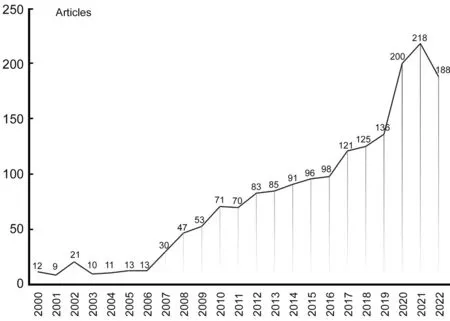
Figure 1 Trend in the growth of publications worldwide from 2000 to 2022.

Table 1 Top 10 influential institutions for PIOL studies
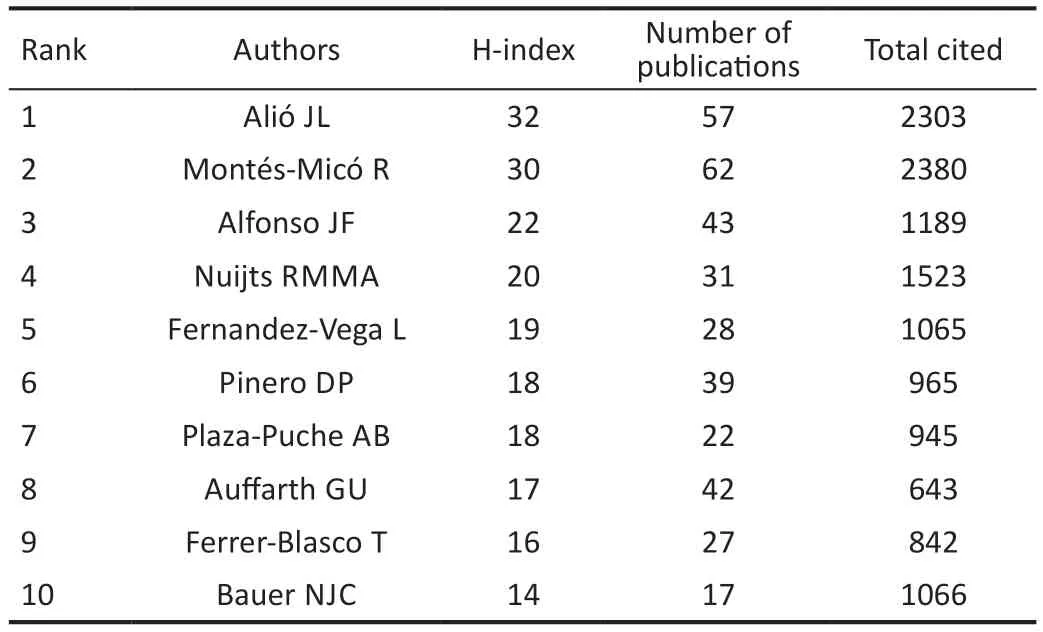
Table 2 Top 10 influential authors for PIOL studies (ranked by H-index)
Author DistributionTable 2 lists the 10 most influential authors in the field of PIOL research.The distribution trend of authors is consistent with that of countries.The authors with the largest number of articles were Montés-Micó R (n=62),Alió JL (n=57), Alfonso JF (n=43), Auffarth GU (n=42),and Pi?ero DP (n=39).All four authors except Auffarth GU,were located in Spain.In addition, through the top-authors’production over time measure generated by R tools, we saw that Montés-Micó R and Alió JL not only published a large number of articles and began publishing early in this research field, the two authors also ranked one or two by the H index(Figure 3A).From the partnership diagram (Figure 3B), we find that there is much cooperation among the top 10 influential authors: the authors collaborating with Montés-Micó R included Alfonso JF, and Fernandez-Vega L.The authors in the group with Alió JL, included Perero DP, and Plaza-Puche AB;In addition, Nuijts RMMA cooperates closely with Bauer NJC.The authors who started early in this field include Montés-Micó R, Alió JL, and Nuijts RMMA.

Figure 2 Trends in the number of articles published in top 5 countries (A) and the map of cooperation among major countries (B).
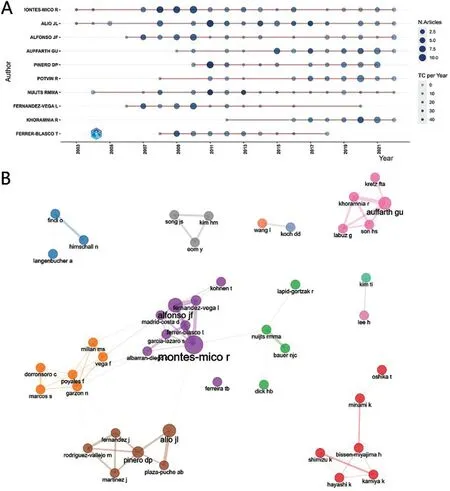
Figure 3 Top 10 influential authors A: Top-authors’ production over time.The size of each dot represents the number of publications in that year, and the darker the dot, the more citations it has received in that year; B: The relationship chart between authors, the thicker the line between the dots, the closer the collaboration.
Influential JournalsA total of 145 journals published relevant articles in this field from 2000 to 2022.Table 3 shows the top 10 journals in terms of the number of publications.We use the H-index to assess the journal’s influence.The journal with the highest H-index is theJournal of Cataract and Refractive Surgery, which also published the largestnumber of related articles (n=427), followed byJournal of Refractive Surgery, with an H-index of 37 and a total of 231 articles.Ophthalmologyrank third in terms of influence, with an H-index of 24.According to Bradford’s Law, the former two journals are core sources in this field.Journal of Cataract and Refractive Surgeryis a specialized ophthalmology journal in the field of cataracts, featuring literature encompassing clinical applications of various PIOLs and innovative reports on corresponding calculation formulas and surgical techniques.On the other hand,Journal of Refractive Surgeryplaces more emphasis on research related to refractive surgery in conjunction with or involving a history of refractive surgery.In addition,Ophthalmology,American Journal of OphthalmologyandEuropean Journal of Ophthalmologyare influential.

Table 3 Top 10 journals for premium intraocular lenses studies (ranked by H-index)

Table 4 Top 10 cited articles for PIOL studies
Most Cited ArticlesThe top 10 most cited articles are shown in the Table 4[25-34].Interestingly, the five most frequently cited articles were those that discussed the postoperative effects of multifocal IOLs compared with monofocal IOLs, while the next five articles mainly focused on the advantages of Toric IOLs in correcting astigmatism after cataract surgery.Five of them were published inJournal of Cataract and Refractive Surgery, while the other five were published inOphthalmology.The top 10 papers were cited over 6000 times in total, the first was cited 261 times, and the 10thwas cited 165 times.Among them, 7 articles were published in 2007-2016(the middle stage), and 3 articles were published in 2000-2006(the early stage).
KeywordsA keyword burst map of the top 30 keywords with the strongest citation burst generated by CiteSpace is displayed in Figure 4.From 2000 to 2022, the most frequently used(strength) keywords were implantation, extraction, contrast sensitivity, restor, range, and extended depth.The keywords that appear frequently in recent years include extended depth of focus, trifocal intraocular lens, range, alignment, and satisfaction.
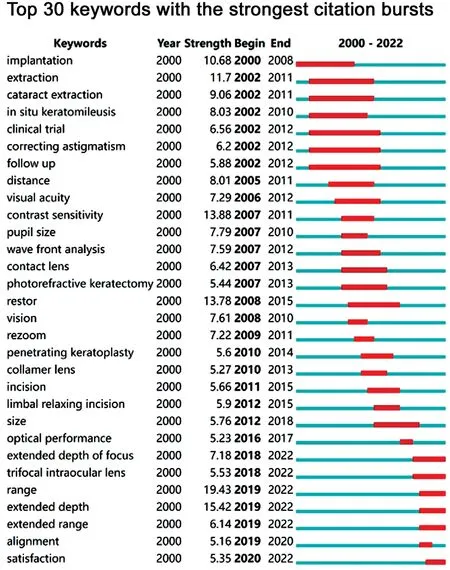
Figure 4 Top 30 keywords burst map by CiteSpace.
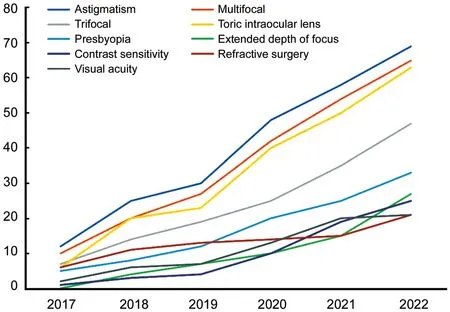
Figure 5 Top 10 keywords from 2017 to 2022.
Then, we analyzed the usage trends from 2017 to 2022 of the 10 keywords with the highest frequency through Bibliometrix (Figure 5), and we found that several terms,including astigmatism, multifocal, and Toric IOL, have the highest frequencies and have been increasing in usage.These finding warrants attention, given the current status of the field.In addition, the frequency of “contrast sensitivity” has increased rapidly since 2019, and “extended depth of focus”has increased rapidly since 2021.
Clustering AnalysisAccording to the results of CitNetExplorer,the retrieved literature can be grouped into 4 clusters.In addition, 135 articles did not fall into any category.The first category contained 936 articles, mainly focusing on various types of multifocal IOLs, visual performance, and the side effects of EDoF IOLs.The second category consisted of 528 articles, focusing on research related to Toric IOLs.The third category mainly addressed the application of PIOLs for various complex corneal diseases (such as keratoplasty and keratoconus,etc.) and included 159 articles.The fourth category contained only 43 articles, mainly focusing on the application of PIOLs in patients after refractive surgery.The connection point between cluster 1 and cluster 2 is a 2010 paper by Hayashiet al[35]titled “Effect of astigmatism on visual acuity in eyes with a diffractive multifocal intraocular lens.”published in theJournal of Cataract and Refractive Surgery.
DISCUSSION
In the last two decades, the PIOL research has gone through several stages, evolving from a small number of studies to a widely discussed topic.A total of 65 countries have participated in PIOL research, among which Spain was the earliest contributor and has made notable contributions.Other countries with major contributions to the field include the United States, China, Germany, and Japan.Collaborations between various countries are very close, particularly among countries with major contributions.We found that the institutions with the most publications are almost all universities in various countries, which clearly shows that the development of clinical research is inseparable from both the general support of universities and the close relationships between ophthalmology departments and major universities.In addition, we find that the authors who started earlier in this field tend to produce more articles and do more in-depth research, which may be related to their long-term accumulated resources and high-level teams.In addition, we find that the journals that publish PIOL-related articles focus on the field of ophthalmology and rarely in comprehensive journals, which may be related to the professional specialization of PIOLs.In a recent bibliometric study by Chenet al[36], a comprehensive exploration was conducted into the advancements in refractive cataract surgery over the past two decades.This investigation encompassed novel surgical strategies and emerging biometric measurement devices, reflecting the evolving landscape within their literature retrieval approach.The iterative updates of IOLs and the progressive improvement in cataract surgical techniques synergistically contribute, significantly enhancing the convenience for cataract patients.In this current study,our focus is predominantly on IOLs, the primary arsenal in our endeavor.Centered on the intrinsic development of IOL,we center our keyword retrieval around PIOL and undertake a comprehensive analysis of PIOL research across different stages.
During the initial phase from 2000 to 2006, the body of research was relatively limited, encompassing primarily animal studies and preliminary clinical observations.The market offered a scant selection of multifocal IOLs, and none that were combined with Toric IOLs.The discipline was navigating its nascent stage, marked by a tentative approach to clinical applications.In an animal experiment, Bootheet al[37]found a method that may be more effective in treating on congenital cataracts by implanting multifocal IOLs combined with extended-wear contact lenses into rhesus monkeys’ eyes.Although they are difficult to access and expensive to use in experiments, rhesus monkeys, the primate closest to humans,are the best available animal model.The success of animal experiments has given clinicians enough confidence that some clinical trials are gradually being carried out, with many in Spain.In a randomized, double-masked clinical trial published inOphthalmologyin 2000, Javittet al[38]found that patients with multifocal IOL implantation had less dependence on glasses and better overall vision than those with monofocal IOL but experienced more visual disturbances, such as glare or halo.In addition to studies of efficacy, we find that there is considerable interest in the side effects of multifocal IOLs: the two most cited articles are about dissatisfaction with multifocal IOLs, but they conclude that most postoperative dissatisfaction can be avoided through effective treatment measures taken in most cases[25-26].Also, Montés-Micóet al[29]reported that the contrast sensitivity performance of multifocal IOL was not as good as that of monofocal IOL at near distances and suggested that patients should be carefully selected when choosing multifocal IOL.On the other hand, there is also active research on toric IOLs, which can correct corneal residual astigmatism after cataract surgery[32].It is estimated that nearly half of cataract patients have corneal astigmatisms greater than 1 diopter (D), which may significantly affect visual acuity after surgery[39].The countries leading early progress in this field were Germany, the United States, and the Netherlands, and included iris fixation[40], Z-haptic[41], and plate-haptic IOLs[42].The biggest problem Toric IOL faces is that, unlike glasses,it may rotate in the eye, resulting in a decline in its ability to correct astigmatism.Ruhswurmet al[43]conducted a longterm follow-up study of 37 eyes (30 patients) implanted with single-piece plate-haptic silicone IOLs from 1993 to 1998 and confirmed that this type of Toric IOL has reliable long-term effects and good rotational stability.
The decade from 2007 to 2016 is the golden period for the development of PIOL; the overall volume of papers has increased steadily, more countries/regions have participated in this field, and a variety of previously proposed concepts have been implemented and applied in the clinic at this stage.The publication of several studies on the clinical application of trifocal IOLs verified the conjecture made by Valleet al[47]in 2005.In 2011, Gatineet al[48]used relevant software to design and verify the theoretical feasibility and effectiveness of the precise combination of two kinds of diffractive profiles to obtain diffractive trifocal IOLs, laying the theoretical foundation for three-focus design.Madrid-Costaet al[49]used an optical bench to measure modulation transfer functions to compare 9 kinds of IOLs, including bifocal and trifocal IOLs, and found that trifocal IOLs had more advantages to performance at intermediate distances.During this period,there were also a variety of trifocal IOL clinical observations and research studies.A retrospective study by Sheppardet al[50]in 2013 found that trifocal IOLs implanted bilaterally could obtain better overall vision.This study was an early clinical study of trifocal IOLs, including only a small number of cases (30 eyes from 15 patients).Good performance of trifocal IOLs was also demonstrated by a study by Mojziset al[51]to correct presbyopia by implanting a trifocal IOL into 60 eyes of 30 patients.Notably, as early as 2014, this team proposed the concept of refractive lens exchange.In addition to various objective indicators, some studies have focused on questionnaires that reflect the subjective feelings of patients,including the Catquest-9SF[52], VFQ-25[53], and Near Activity Visual questionnaire[50].
There is a significant connection point between the Toric and multifocal IOL studies.In the cluster analysis, we found that this connecting node was an article titled: Effect of astigmatism on visual acuity in eyes with a diffractive multifocal intraocular lens[35].This article showed that among patients with a bifocal IOLs, those with 1.50 and 2.00 D astigmatism had worse postoperative visual acuity at all distances than those with astigmatisms of 0 and 0.50 D suggesting the need to reduce corneal astigmatism below 1.00 D when implanting a multifocal IOL.Large preoperative corneal astigmatism often limits the application of multifocal IOLs, which results in poor visual acuity at all distances postoperatively[54].Broadening the types of multifocal IOLs, multifocal IOLs with toric designs have been available since 2007[55].A retrospective study by Mojziset al[56]included 64 eyes of 35 patients implanted with a bifocal Toric IOL model AT LISA 909M, which found that a main incision of less than 2.2 mm is preferable for PIOLs.In addition to multifocal IOLs, EDoF IOLs have seen widespread adoption in clinical practice in recent years.EDoF technology is meticulously crafted to augment the depth of focus, necessitating a seamless optical profile devoid of abrupt transitions in either refraction or diffraction.When the distance between focal points falls within a specific range, these points seamlessly connect, forming a continuous visual field.The principles underpinning EDoF IOLs encompass diffraction,wavefront aberration, and small-aperture imaging[57].EDoF IOLs offer distinct advantages over conventional multifocal IOLs, exhibiting reduced visual interference and heightened tolerance for refractive errors[58].Specifically, EDoF IOLs outperform other multifocal counterparts in challenging scenarios, such as IOL power calculation in post-refractive patients, instilling greater confidence in the process.In a study by Ben Yaishet al[59], an optical bench based on the Lobb eye model compared EDoF IOLs with conventional bifocal IOLs (AcrySof ReSTOR SA60D3, Alcon Laboratories Inc.Japan), highlighting EDoF’s significant advantage in increased tolerance to decentration and astigmatism.A retrospective study by Torun-Acaret al[60]demonstrated high patient satisfaction, good contrast sensitivity, and marked overall vision improvement in individuals implanted with a trifocal IOL combined with EDoF technology, albeit with a relatively limited sample size (80 eyes of 40 patients) at the time of publication.In contrast, Cocheneret al[61]conducted a larger multicenter study in 2016, including a total of 822 eyes (411 patients) implanted with EDoF IOLs, affirming the conclusions drawn by Torun-Acar.EDoF IOLs have become a focal point in the development of PIOLs due to their exemplary design principles, cohesive focus switching, heightened ability to accommodate refractive errors, and comparatively lower incidence of visual disturbance.
Apart from the innovation and development of IOL materials,PIOL applications have expanded from routine cataract patients to encompass special cases at this stage.Relevant keywords from the top 30 keywords included photo refractive keratectomy and laser-assistedin situ keratomileusis.Due to their altered corneal morphology and the deviation from the normal range of the eye axis, patients have a greater chance of deviations in the IOL power calculation and often have difficulty taking advantage of PIOLs after surgery[62].Khoramniaet al[63]reported a case of a patient who had undergone multiple refractive surgeries and achieved better distance and near visual acuity after the implantation of a PIOL, showing that PIOLs could provide relatively accurate results even in challenging cases.Similarly, a clinical trial by de Oliveira Freitaset al[64]confirmed the feasibility of multifocal IOLs in post refractive surgery patients.Additionally,refractive surgery may help patients with an implanted PIOL to correct residual refractive error from surgery and improve postoperative outcomes[60].Although the proportion is currently small, with the increasing age of those who have undergone refractive surgery, we believe that there will be many patients who can benefit from a second refractive surgery in the future,and research into this application is currently lacking.
In the six years from 2017 to 2022, the number of articles on PIOL increased sharply and shifted from predominantly theoretical research to mainly clinical studies.In the previous stage, we found that except for China, which ranked eighth,the top ten countries with published articles were developed countries with well-established health care systems.At this stage, not only had the number of articles published by China increased significantly and risen to second place, but India and Turkey were also among the top ten countries.The large number of patients with cataracts in developing countries will be a potentially expansive market for PIOLs.In addition, some of the latest generations of artificial intelligence-based IOL power calculation formulas (including the Kane, Hill-RBF,and PEARL-DGS formula) need to obtain a large amount of local patient data to optimize training and computation accuracy.Therefore, we expect the proportion of articles from developing countries to continue to increase[65].
Another noteworthy trend is the increase in the proportion of Toric IOL research.Through keyword analysis in this period, we found that the related keywords, “astigmatism”and “Toric intraocular lens” were the first and third most common, respectively.Their frequency even exceeds that of multifocal IOL.We speculate that this may be related to the widespread use of PIOLs and the importance clinicians attach to the correction of astigmatism, and PIOLs are no longer contraindicated for many patients with high astigmatism and even some patients with irregular astigmatism[5,66-67].Because nearly half of patients requiring cataract surgery have corneal astigmatism that needs to be corrected, multifocal IOLs combined with Toric function are widely used.A multicenter prospective clinical trial included 227 eyes of 114 patients with trifocal Toric IOL implantation, and after a 12-month observation found that the patient satisfaction reached 98.1%,which reflected good overall visual acuity while correcting astigmatism.At the same time, they also reported that halos,the main photic phenomena, are unavoidable in this kind of IOL[68].Similarly, the research of Rementeria-Capeloet al[69]also showed that the performance of trifocal Toric IOLs is almost the same as that of non-Toric versions on the same platform.In addition, a study by Paulet al[70]found that trifocal toric IOLs were also deemed highly satisfactory by people who received refractive lens exchange, but this study also found a high proportion of patients experiencing postoperative halo.
We have seen a steady increase in the number of publications and keyword highlights for EDoF IOL in recent years.Clinical application of EDoF IOLs may also increase because it can provide continuous vision over a range of distances, is closer to human eye perception, and has fewer visual disturbances.A retrospective comparative study by Zhuet al[71]found that EDoF IOLs had the best quality of vision and the least photic disturbance compared to non-EDoF multifocal IOL; however,near visual acuity was worse than that of conventional types.Similarly, Karuppiahet al[72]found that the EDoF group had better contrast sensitivity than the trifocal non-EDoF IOL group.However, the current EDoF IOL also has the significant disadvantage of insufficient near vision, which may require glasses for viewing near object.An improvement in near vision has been reported for a newer model of EDoF IOL TECNIS Synergy (model ZFR00V); however, this IOL is not yet available in several countries and regions, and supporting studies are still scarce, although we expect more relevant studies to emerge[73-75].We believe that a satisfactory IOL should include the following features: good contrast, overall vision, and as few photic disturbances as possible.Trifocal IOLs based on EDoF technology seem to fulfill all these criteria.
In addition to the IOL types mentioned above, there is another relatively rare type, accommodative IOLs.They do not have a multifocal design but can use the contraction of the ciliary muscle to change the diopter of the IOL to achieve visual ability at different distances.This type of IOL retains ciliary muscle function through complex processes and aims to restore the regulation of the normal human lens[76].However,this kind of IOL has not been widely used in the clinic, and there is only one approved IOL by the FDA: the AOU1V/AOU2V (Crystalens, Bausch & Lomb)[77].There are still only a few studies on this kind of IOL, but we believe that this type of IOL will gradually mature and become widely used in the clinic.
Beyond technical advancements, our primary focus centers on addressing the evolving visual requirements of patients.Patient satisfaction stands as a pivotal criterion for evaluating the efficacy of an IOL.In certain studies, particularly during the developmental stages, questionnaires were employed to capture patients’ subjective perceptions of the IOL[50,52-53], a methodology we find apt.We advocate for the development of improved or specially tailored questionnaires for postoperative cataract patients, encouraging researchers to increasingly consider and integrate patient perspectives and needs.And in our preoperative assessments, we should pose detailed inquiries to patients, aiming to understand their preferences and requirements thoroughly.This proactive approach enables clinicians to select a type of PIOL that aligns optimally with the individual patient’s needs and lifestyle.
The involvement of multiple countries and regions, along with collaborations across multiple centers, is crucial for the clinical observation of newly developed PIOL.Collaborations with universities serve as a key avenue for obtaining essential technical support.The innovation of new PIOLs necessitates exploration in various aspects,including new optical mechanisms, the integration of existing technologies, and addressing patient needs.Similarly, as we observe the promising clinical applications of new PIOLs, we anticipate the emergence of novel types.Our considerations extend beyond objective indicators to include the subjective satisfaction of patients.However, due to the scarcity of literature on accommodative IOLs at present and the inability to establish definitive trends, we excluded it from the retrieval.Furthermore, our study focused solely on English literature,resulting in the exclusion of documents published in German or other languages from the statistical analysis.
ACKNOWLEDGEMENTS
The authors thank all participants of this study for sharing their time and experiences.
Authors’ contributors:Conceptualization, Yuan XY and Hua X; methodology, Li LP; software Mao DS; writing—original draft preparation, Li LP; writing—review and editing, Yuan LY; visualization, Yuan LY; supervision, Yuan XY and Hua X;all authors have read and agreed to the published version of the manuscript.
Foundations:Supported by the National Natural Science Foundation of China (No.82371033; No.81970772); the Tianjin Natural Science Foundation (No.21JCZDJC01250);the Tianjin Key Medical Discipline (Specialty) Construction Project (No.TJYXZDXK-016A).
Conflicts of Interest: Li LP,None;Yuan LY,None;Mao DS,None;Hua X,None;Yuan XY,None.
 International Journal of Ophthalmology2024年4期
International Journal of Ophthalmology2024年4期
- International Journal of Ophthalmology的其它文章
- Comment on: Recurrence after spontaneous separation of epiretinal membrane in a young woman: a case report
- When to repair a retinal detachment?
- Bilateral iridocorneal endothelial syndrome-Chandler’s syndrome: a case report and literature review
- Penetrating canaloplasty in corticosteroid-induced glaucoma: a report of two cases
- On-spot preparation of EDTA solution for the treatment of band keratopathy: a case report
- Non-contact wide-field viewing system-assisted scleral buckling surgery for retinal detachment in silicone oilfilled eyes
